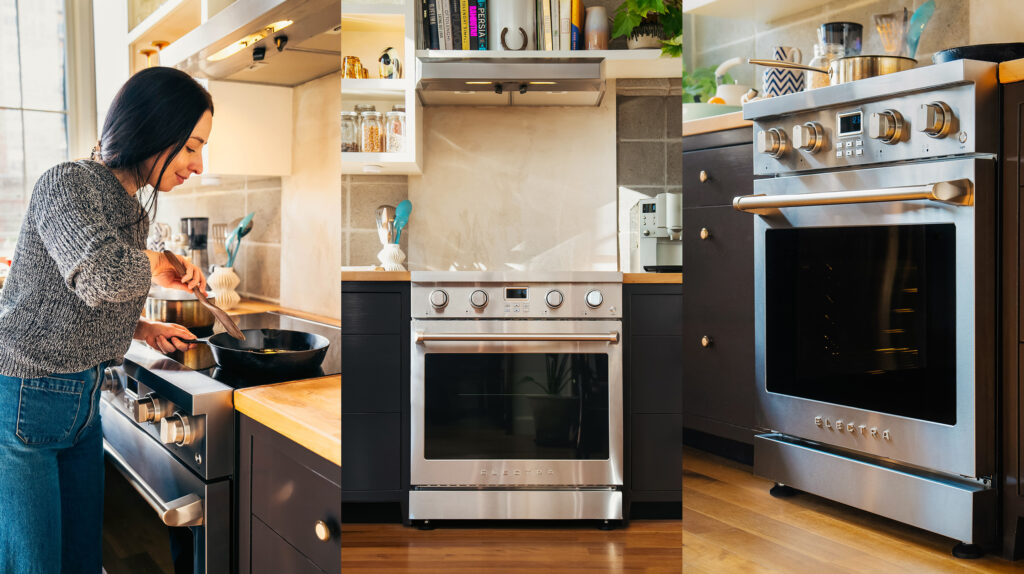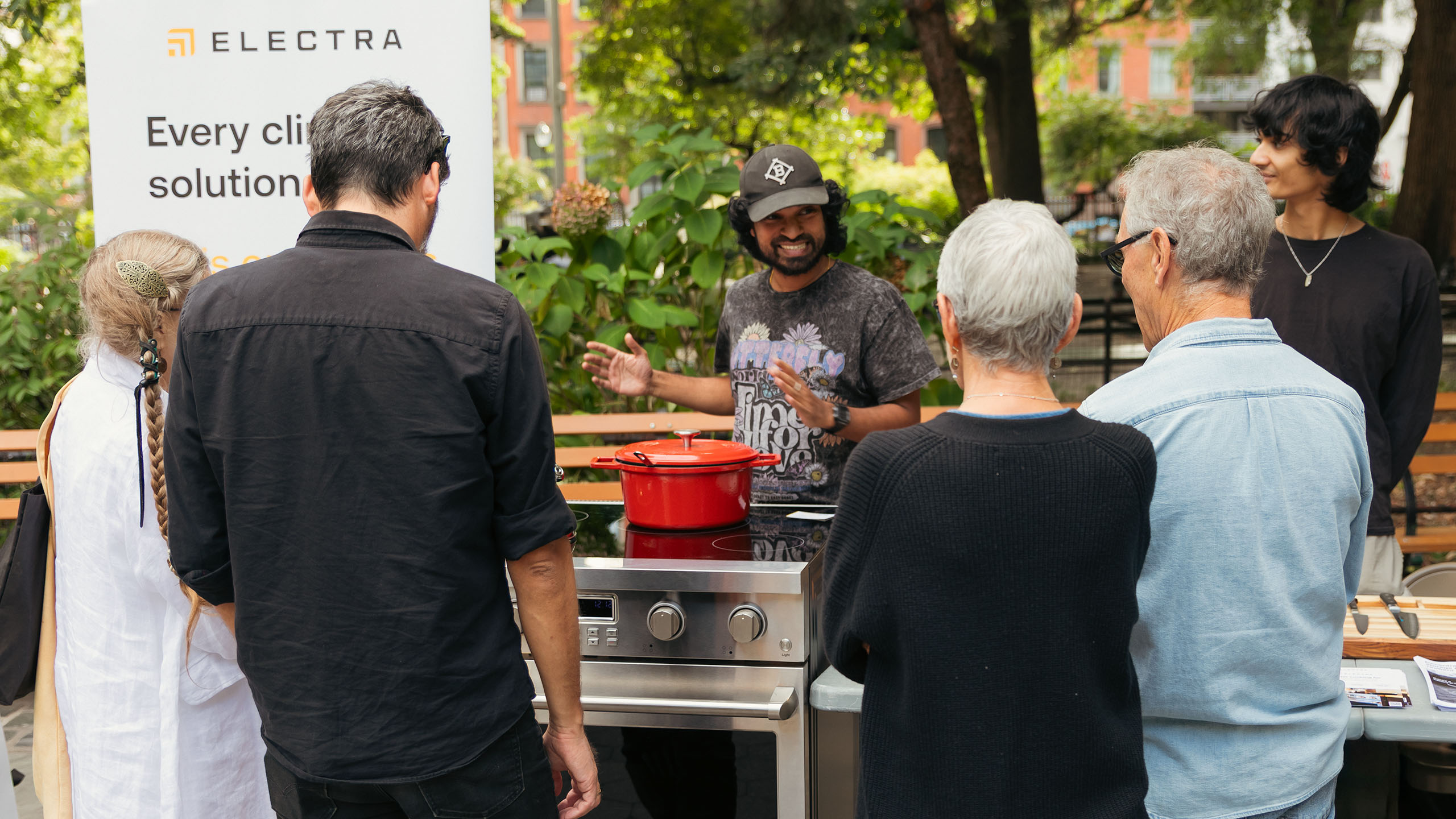On a September afternoon during Climate Week in New York, a small crowd gathered in a Lower East Side park around a full-size stainless-steel kitchen range. It looked like something that could fit in any regular apartment kitchen, yet it was running outdoors, sizzling vegetables in a pan without a generator, gas line, or high-voltage hookup. Passersby stopped to watch as it kept cooking even without power.
The stove was Electra’s new 30-inch induction range, a battery-backed appliance designed to operate on a standard 120-volt outlet and keep running through outages. Beneath its typical knobs and burners sits a five-kilowatt-hour lithium iron phosphate pack that charges quietly between meals, then delivers high-power cooking on demand, offering a glimpse of a kitchen that’s both cleaner and more dependable.
The Barriers to Going Electric
That small scene in New York hinted at something bigger: the shifting priorities and persistent challenges shaping how Americans cook at home.
More Americans are becoming aware of the dangers of indoor air pollution that can come from cooking with a gas flame. Studies show typical gas burners deliver only about 40% of their energy to the pan while emitting benzene and elevating indoor nitrogen dioxide — pollutants that induction cooking avoids by eliminating combustion altogether, alongside delivering up to 90% of its energy to food.
However, there are a few barriers preventing a switch from gas to electric.
First, many regions are susceptible to extreme weather and poor grid installations. Since the year 2000, roughly 80% of major U.S. power outages have been caused by weather events, an issue that makes electric cooking a tricky proposition.
Additionally, many buildings and houses don’t allow 240-volt appliances, and upgrading a panel or adding circuits can be a costly expense for many households or a structural change that many condo owners and co-op residents aren’t allowed to make.
As a result, induction has become far more common overseas, with about 22% of households in Western Europe now using induction cooktops, while in the United States, adoption continues to hover around 3%.
That bottleneck has led to a recent surge in companies, like Electra, Copper, and Impulse Labs, developing battery-equipped induction models that can plug into standard, 120-volt outlets while still delivering full cooking power — showing a growing industry effort to make electrification possible in homes that can’t be rewired.
Among these options, Electra stands out for delivering a full-size range with multiple high-end features, all at a more accessible price point than other battery-backed models.
How Electra’s 120-Volt Range Solves the Problem
At first glance, Electra’s 30-inch slide-in range presents a classic look, with stainless steel, four burners, and a convection oven. But what sets it apart is how it brings full-size induction cooking to homes without the wiring work most ranges demand.

On the surface, the cooktop features two 1,800-watt heating elements paired with two 900-watt units, while the oven delivers 1,800 watts of power from both the top and bottom elements and adds a fan and 1,300-watt heating element for its air-fryer mode. The range ships with a standard three-prong NEMA 15 plug, and its built-in “breaker saver” can cap the current draw to 15, 10, 5, or even 2 amps when sharing a circuit — useful for older homes and apartments.
At the core is Electra’s lithium-iron-phosphate (LFP) battery system, engineered with multi-layer safety architecture and rated for roughly 6,000 cycles, the equivalent of more than 15 years of typical use with 80% capacity remaining. It’s built to last and can be serviced by any qualified technician.
All of this enables what the company calls the “plug-in, not tear-out” promise. Instead of demanding a 240-volt circuit or a costly panel upgrade, the range connects to a standard 120-volt, 15-amp outlet. The 5kWh LFP pack quietly charges between meals and delivers instant heat when cooking, supplying full-size performance with no rewiring, permits, or mess. As Electra CEO Bert Muthalaly puts it, “You just slide the gas stove out and plug Electra in.”
That same battery gives Electra another edge: resilience. During a power outage, the stove keeps running by automatically using the energy stored when electricity was cheapest and cleanest. This allows the system to keep cooking for several meals, a quiet reassurance for households in areas with recurring blackouts.
The oven includes a convection fan with a built-in heating element that doubles as an air-fryer mode, while the front panel features familiar knobs and physical buttons for easy control.
And because induction heats the pan rather than the surface, sensors automatically shut off the burners or oven if excess heat is detected, protecting both children and older adults — making Electra a cleaner, more efficient appliance suited to any household.
A Market Catching Up to Demand
The growing popularity of products like Electra reflects a broader moment for all-electric living, becoming a market category on its own and gaining traction in policy and everyday life. New York’s Local Law 154, for example, phases out fossil fuel combustion in most new buildings, and California’s 2026 energy code will require all-electric readiness. These changing policies, in turn, leave a gap that practical, plug-in solutions are starting to fill.
This has also grown with initiatives like New York City’s Induction Stove Challenge, which invited 120-volt battery-equipped designs for older buildings. The initiative was ultimately won by Copper, whose $6,000 induction range earned a 10,000-unit contract with the New York Housing Authority, bringing induction stoves to thousands of homes across the state.
Electra saw that growing interest firsthand during its Climate Week demonstration, when the team set up the stove in a Lower East Side park and saw commuters astonished that a full-size range could boil water without needing to be plugged into an outlet.
“People kept saying, ‘I’ve been waiting for this,’” said Muthalaly. Many had wanted induction for years but believed it would mean tearing up walls or upgrading entire panels. Watching the stove in action, this option finally looked easy.
A New Way to Cook
At $3,999, Electra’s currently positioned as a more accessible battery-integrated option, roughly $2,000 less than comparable full-size models on the market. Deliveries are scheduled to begin in February 2026, with flat $250 U.S. shipping and haul-away included.
The company notes that the range’s LFP pack meets the IRS §48E criteria for battery storage, which may apply to commercial and multifamily installations, and could also qualify for a 30% federal clean-energy investment tax credit, with local rebates (such as California’s $4,250 Energy-Smart Homes rebate) potentially further lowering costs. Of course, eligibility can vary, so it’s always best to check with a tax professional to confirm what incentives apply.
For co-ops or condos where rewiring isn’t an option, parents who want safer surfaces around small hands, older homeowners who worry about leaving the gas on, or anyone in blackout-prone suburbs, Electra offers a plug-in solution that’s both practical and reliable.
You can reserve your Electra stove now.

